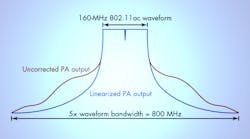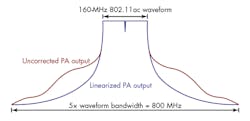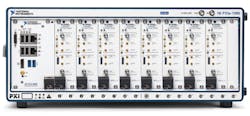The Evolving Wireless World Requires a New Test Approach
This file type includes high-resolution graphics and schematics when applicable.
Wireless technology is ubiquitous, providing the means for communicating voice, data, and video around the world. It is quickly expanding from just human users to machine-to-machine (M2M) communications and Internet of Things (IoT) sensors connected to the internet for full-time access and control.
Within a decade, the number of connected devices is projected to outnumber people by 10 to 1. As a result, emerging and future wireless communications standards are transforming to address cases involving things as well as human users. The large number of things connected by wireless technologies will require new instrumentation and effective measurement approaches to meet future demands of a wirelessly connected world. The modular PXI instrument approach provides the capability and flexibility to meet those future wireless device measurement needs.
The vision of the International Telecommunication Union (ITU) for International Mobile Telecommunications in 2020 (IMT-2020) outlines one of the clearest requirements for the range of use cases in future wireless standards. This foresight, designed as a framework to communicate the technical requirements of Fifth-Generation (5G) cellular communications, outlines three distinct wireless use cases (Fig. 1). Although these use cases specifically define the requirements of future mobile communication standards, they reflect the changing requirements for technologies like IEEE 802.11ad, IEEE 802.11ax, Bluetooth 5.0, near-field communications (NFC), and more.
Use Cases Look to the Future
The first wireless use case, Enhanced Mobile Broadband (eMBB), defines the evolution in network capacity and peak data rates expected from a future wireless technology. eMBB technologies will drive higher peak data rates through a combination of wider bandwidths, higher-order modulation schemes, and multiple-input/multiple-output (MIMO)/beamforming technologies. Specifically for 5G, the eMBB use case is designed to deliver as much as 10-Gb/s downlink throughput, which is 100× the capability of single-carrier Long Term Evolution (LTE) cellular communications systems.
The second use case, Massive Machine-Type Communication (mMTC), is designed to deliver wireless access to more devices in more locations at low cost. By linking together more devices in more locations, mMTC technology will connect traffic lights, automobiles, and even highways in a smart, wirelessly connected city. In the short term, the need to cost-effectively connect more devices in more Industrial IoT (IIoT) applications is driving new mobile technologies, such as LTE for M2M communications and narrowband IoT (NB-IoT).
The third and final use case is Ultra-Reliable Machine-Type Communication (uMTC). In this scenario, two key requirements of a wireless connection are latency and packet error rates. One example is a doctor performing remote surgery using a robot connected via wireless link. Another example is an automobile avoiding a massive traffic pileup and delays by communicating the existence of a vehicular wreck on the road ahead of it. In both applications, the reliability of the wireless communications link is not just a convenience, but a lifesaver.
The requirements of tomorrow’s wireless technology are not only driving new wireless standards like NB-IoT, 5G, and IEEE 802.11ax, but are also changing the way engineers design and test mobile devices. For example, wider bandwidths in future standards such as 5G require wider-bandwidth RF/microwave instruments. In addition, multiple-antenna technologies like MIMO and beamforming produce a need for modular and flexible instrumentation that can scale from testing single-antenna devices to 8 × 8 MIMO devices and beyond.
On top of that, lower-cost radios also require lower-cost approaches to wireless test. In a scenario where future wireless radios cost only 20% of today’s prices, next-generation test equipment must be capable of much increased throughput, using faster and more parallel test approaches.
Modular Test Approach
The PXI Vector Signal Transceiver was introduced by National Instruments in 2012 as a modular alternative to traditional “one-box” test solutions. The VST combined a 6-GHz RF signal generator, 6-GHz RF signal analyzer, and user-programmable field-programmable gate array (FPGA) in a single PXI module. It provided performance suitable for both research and development (R&D) and manufacturing test, with a user-programmable FPGA that made it possible to change the functionality of the VST for applications ranging from measurement acceleration to channel emulation.
Because of the continuing evolution of wireless technology, a second-generation VST was needed to address future requirements, one with wider bandwidth, extended frequency range, and a larger FPGA in an even smaller form factor than the first-generation instrument (see “RF Measurement Modularity Redefined”). The second-gen VST not only addresses some of today’s most challenging wireless test needs, but also offers the flexibility to address tomorrow’s wireless test requirements.
Over the past decade, wireless standards have evolved to use significantly wider bandwidth channels to achieve higher peak data rates. For example, since 2003, Wi-Fi has advanced from 20 to 40 MHz to 160 MHz in modern IEEE 802.11ax applications. Mobile communication channels have evolved from 200 kHz in Global System for Mobile Communications (GSM) cellular systems to 100 MHz in modern LTE-Advanced (LTE-A) technology. Future wireless technologies such as LTE-Advanced Pro (LTE-A Pro) and 5G will drive this trend even further.
The bandwidth of a signal analyzer should exceed that of a device under test (DUT), especially when testing semiconductor devices. For example, when testing RF power amplifiers (PAs) using digital predistortion (DPD) to improve linearity, the test equipment must extract a PA model, provide corrections for nonlinear behavior, and then generate a corrected waveform. Advanced DPD algorithms often require three to five times the RF signal bandwidth of the DUT (Fig. 2). As a result, instrument bandwidth requirements can be as much as 500 MHz for LTE-A (for a 100-MHz signal) and 800 MHz for IEEE 802.11ac/ax (for a 160-MHz signal).
One of the most significant enhancements of the second-generation VST is its wider instantaneous bandwidth of 1 GHz. Due to its wider bandwidth, engineers can tackle challenges with this second-generation VST that simply can’t be solved with less-available analysis bandwidth.
Numerous applications besides wireless test demand wideband instruments. For example, wideband radar systems often require as much as 1 GHz of signal bandwidth to acquire pulsed signals. Also, in spectrum monitoring systems, the bandwidth of the instrument can dramatically improve the scan rate. Finally, wide signal bandwidth is an essential requirement for many advanced research applications.
Testing Must Keep Pace with Standards
A second critical requirement of test equipment for next-generation wireless standards is providing sufficient measurement accuracy to evaluate the enhanced specifications of these emerging standards. With higher-order modulation schemes and wideband multicarrier signal configurations, the RF/microwave front ends currently employed in wireless communications devices will need much better linearity and lower phase noise to support the more complex modulation schemes of emerging systems.
For example, when assessing the error-vector-magnitude (EVM) performance of a wireless device, an RF/microwave signal analyzer should typically deliver EVM performance that is at least 10 dB better than that of the DUT. Modern IEEE 802.11ac devices need EVM performance of –32 dB when generating the required 256-state quadrature-amplitude-modulation (256QAM) scheme. As a result, the test analyzer must achieve EVM performance of –42 dB or better. In the future, the IEEE 802.11ax 1024QAM scheme will likely push device EVM limits to –35 dB, with corresponding instrument EVM requirements of –45 dB (Fig. 3).
To achieve superior EVM performance for wideband signals, the second-generation VST leverages advanced, patent-pending, in-phase/quadrature (I/Q) calibration techniques. In addition, PXI modularity enables engineers with the most demanding EVM performance requirements to further improve on the VST’s native performance. Using an external PXI local oscillator (LO), systems based on the second-generation VST achieve EVM performance of better than –50 dB.
Dealing with MIMO Test
Modern communications standards ranging from Wi-Fi to mobile systems and equipment use sophisticated multiple-antenna technology. In these systems, MIMO configurations provide a combination of either higher data rates through more spatial streams or more robust communications through beamforming techniques. Because of these MIMO benefits, next-generation wireless technologies such as IEEE 802.11ax, LTE-A Pro, and 5G will use more complex MIMO schemes with as many as 128 antennas on a single device.
Not surprisingly, MIMO adds substantial design and test complexity. It not only increases the number of ports on a device, but also introduces multichannel synchronization requirements. To evaluate a MIMO device, RF/microwave test equipment must be able to synchronize multiple signal generators and signal analyzers. Test equipment form factors and synchronization methods are critical to achieving practical solutions for such measurement requirements.
The second-generation VST is compact enough to enable the installation of as many as eight VSTs in a single 18-slot PXI chassis, with one slot reserved for a PXI controller (Fig. 4). The VST offers a range of technologies to tightly synchronize it either with other VSTs or other PXI modules. For example, the patented T-Clock technology developed by National Instruments can synchronize as many as eight VSTs to within 1 ns of channel-to-channel skew. In addition, the LOs of each VST can be shared with one another to conduct completely phase-coherent RF signal generation and acquisition.
Get with the Programmability
Software programmability is a key requirement for next-generation wireless test systems. Advanced wireless test applications increasingly require engineers to tailor the behavior of the instrument’s firmware. In these applications, engineers can significantly improve instrument performance simply by moving closed-loop control, measurement acceleration, real-time signal processing, or synchronous DUT control on the instrument itself.
Historically, the only way to customize an instrument’s firmware was to negotiate a nonrecurring-engineering (NRE) fee with the test vendor, which was usually expensive. In contrast, having the FPGA programmability of the VST allows users to attain all of the benefits of custom firmware. Users can also make their own modifications in test programs rather than hiring a costly expert in VHDL or Verilog code for the task.
One application that software-designed instrumentation can uniquely solve is radar prototyping. In this application, customers are able to use the FPGA as a complete target simulator. In radar applications, a radar system detects a “target,” such as an automobile, airplane, or other object, by sending a stimulus signal and then waiting for the response. Attributes of the stimulus’ reflection off the target, such as the delay and frequency shift, indicate both the distance and velocity of the target. The combination of the VST’s wide bandwidth and user-programmable FPGA makes it well-suited for target emulation (Fig. 5). In addition, engineers can easily customize the FPGA to modify the types of targets they need to simulate.
Another application that reaps significant benefits by modifying the user-programmable FPGA is measurement acceleration. When performing measurements such as EVM or adjacent-channel-power (ACP) testing on wireless devices, the total measurement execution time is dominated by the measurement algorithm. For these measurements, it is possible to reduce measurement time by moving the measurement algorithm to the FPGA.
In addition, many of these measurements are often made under DPD conditions. In these cases, engineers can also use the FPGA to develop their own custom, real-time DPD implementations. The faster FPGA-based DPD implementation saves critical test time, and allows engineers to embed highly protected FPGA algorithms. By delivering an FPGA bit file to prospective customers instead of source code, organizations are better able to protect their DPD intellectual property (IP).
HW + SW
One of the most important features of the VST is that it is part of a complete hardware and software platform. In the current era of smart, connected devices and ICs, modern test instrumentation has transitioned from discrete instruments to highly integrated test systems. As a result, meeting the latest measurement challenges like envelope-tracking PA test and radar prototyping requires a platform of instruments that can be synchronized, customized, and easily controlled with software.
The VST is an example of how modular hardware and open software are increasingly being used to developer smarter, more efficient test systems. With more than 600 PXI products currently on the market, ranging from dc through millimeter-wave frequencies, these instrument modules achieve high-throughput data flows using Gen 3 PCI Express bus interfaces and sub-nanosecond synchronization with integrated timing and triggering. By leveraging intuitive software tools, a vibrant ecosystem of partners, add-on IP, and applications engineers working on practical solutions for current and emerging standards, it is possible to dramatically lower the cost and time required for testing wireless communications standards using this platform-based approach.
Although the next wave of wireless technologies, from 5G to IEEE 802.11ax, will introduce significant design and test challenges, the second-generation VST was created explicitly with the performance flexibility to address them. With wider bandwidth, a smaller form factor, excellent RF performance, and software customizability, the VST is scalable to meet the most difficult test challenges today and tomorrow.







